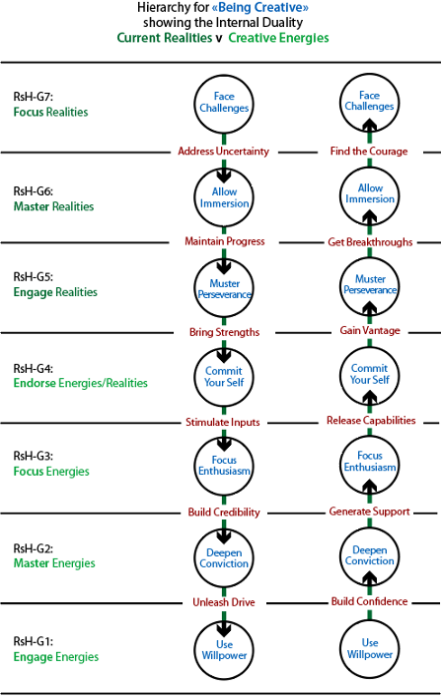From Courage to Willpower (& back)
The natural relationships reveal a flow from Grouping to Grouping (G in formulae) as explained earlier and reviewed here. This will be developed as channels from Level to Level in this section. Moving Downwards is the focus for elaboration. For more detail, review the previous section.

Moving Downwards
 RsH-G7: Creativity starts with courageously accepting a challenge.
RsH-G7: Creativity starts with courageously accepting a challenge.
The function of a challenge is to propel you to embark on a worthwhile task (or project or venture) despite its evident difficulties for you and uncertainties that might lead to failure.
The natural fears associated with any challenge are mastered through the evocation of courage. This does not remove fear, but rather leads to a positivity that keeps you on track as you address the challenge.
However, nothing significant happens until you address uncertainties and get to grips with whatever makes the challenge feel like a challenge.
 RsH-G6: Allowing immersion in the challenge enables breakthroughs.
RsH-G6: Allowing immersion in the challenge enables breakthroughs.
The function of breakthroughs is to resolve blocks.
Conventional creativity theory focused on preoccupation, emphasizing preparation and incubation as the prelude to the needed inspiration. However, breakthroughs can also occur through deliberate experimentation. These trials focus more on seeing what happens than on expecting a definitively success.
However, your breakthroughs depend on their integration and contribution to the continuing progress of your project, even if this is sometimes slow and painful.
 RsH-G5: You can gain vantage through perseverance.
RsH-G5: You can gain vantage through perseverance.
The function of vantage is to put you in a position that maximizes your chances to overcome the certain difficulties and inevitable obstacles for your project, whether these are internal (e.g. doubts, negativity) or external (e.g. set-backs, failures).
Perseverance requires the establishment of regimens to which you adhere, regardless of eventualities. You must be determined to make progress, even if the steps are tiny, continually justify your activities to remain rational and avoid blind alleys or sacrifice traps, and ensure motivation to sustain your energetic participation.
However, perseverance is only as effective as the personal strengths you can bring to bear.
 RsH-G4: You commit yourself and all your capabilities to the project.
RsH-G4: You commit yourself and all your capabilities to the project.
The function of capability is to handle any demands of the challenge. However, your full capabilities are only released if you inject commitment and identify yourself with the project. You usually discover strengths that you never knew you had.
Commitment is developed by a surrender to your project, becoming passionate about progress, playing with ideas, and learning through experience.
However, commitment does not provide everything needed: you must stimulate inputs from yourself and others.
 RsH-G3: Generate support through focusing your enthusiasm.
RsH-G3: Generate support through focusing your enthusiasm.
The function of support is to confirm the value of your efforts as well as to access willing appropriate input.
Enthusiasm is based on activating, appreciating, sharing, interesting and engaging yourself in relation to the many activities demanded by your challenging project. You may need to handle others similarly.
However, enthusiasm must rest on a growing credibility in regard to what you intend.
 RsH-G2: Express confidence by deepening your conviction.
RsH-G2: Express confidence by deepening your conviction.
The function of confidence is to underpin stated convictions and provide reassurance and credibility in your approach to the challenge.
Conviction demands that you dedicate yourself, become involved, generate useful conceptions, take ownership of your project, reach conclusions that allow movement, and oversee activities and events.
However, confidence and conviction depend on unleashing your inner drive so as to move forward freely and powerfully.
 RsH-G1: Autonomy enables the fullest use of your willpower.
RsH-G1: Autonomy enables the fullest use of your willpower.
The function of autonomy is to release personal energies for your own purposes. Willpower flows through the conduits of autonomy (which are the same elements as the levels in the hierarchy of endeavour) and gets direction from your integrity.
Integrity in your use of willpower requires that the higher transcendental levels are enhanced. So your willingness-RL7 must be full and complete, purpose-RL6 must never be forgotten, while communication-RL5 and experiencing-RL4 require continual intensification.
The actualization levels are more simply directed: change-RL3 should be targeted, inquiry-RL2 focused, and action-RL1 taken.
 Moving Upwards
Moving Upwards
Start at RsH-G1 where your willpower provides access to the inner energies that are the foundation of all creativity.
But you require confidence to be autonomous, so …
RsH-G2: Deepening conviction affects your participation in any project, is essential for its crucial specifications, and underpins your understanding as the project evolves. This is what determines credibility, at least in your own eyes.
But you must generate support when it comes to actual activities, so …
RsH-G3: Focusing your enthusiasm provides for energies to be applied to maximum effect both by yourself and (as appropriate) via others.
But you must bring all personal capabilities into play, so …
RsH-G4: Committing your self allows you to discover, develop and apply whatever abilities and strengths are relevant.
But you must gain vantage to minimize failures and handle difficulties, so …
RsH-G5: Mustering your perseverance makes it likely that you can overcome, whatever the external obstacles or emerging inner doubts.
But you must get breakthroughs when you are blocked, so …
RsH-G6: Allowing immersion in the project allows you to deal directly with the most profound mysteries and seemingly insuperable difficulties.
But you must develop the courage, so …
RsH-G7: Facing the challenge is a necessity. Feeling fearful is natural, given the obvious difficulties and a definite risk of failure, especially if you misjudge the challenge.
- With this idealized picture in mind, the first requirement is to identify the intrinsic tension (dynamic duality) that makes for pressures and problems in practice.
Originally posted: 9-Mar-2012
